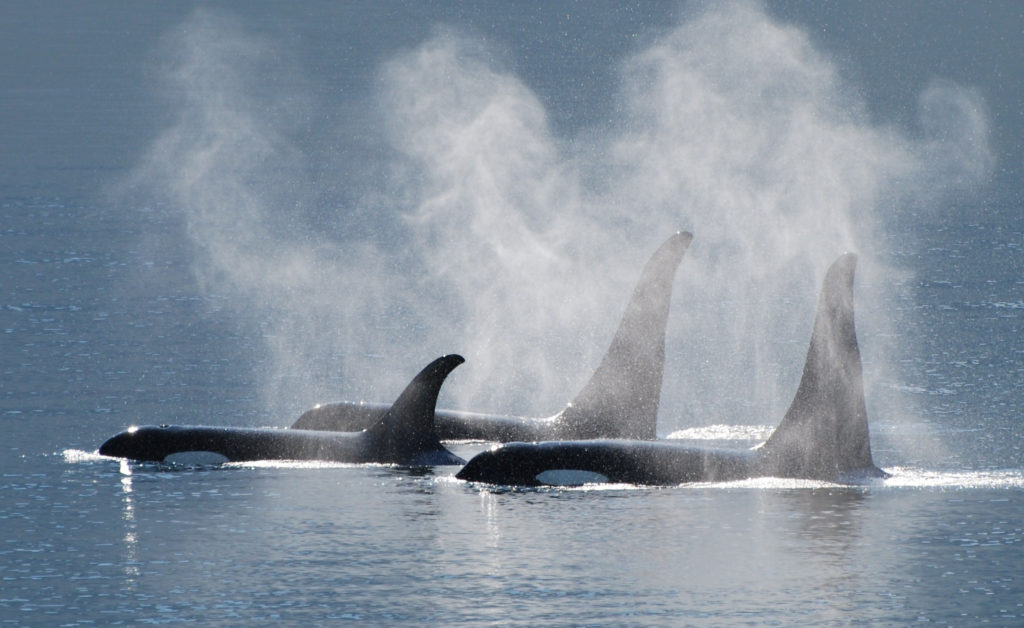by Tina Kelly, Shaw Centre for the Salish Sea –
Meet Eve. Eve’s skeleton hangs near the touch pool at the Shaw Centre for the Salish Sea. To scientists Eve was known as A9, a killer whale or orca who once inhabited the waters around Northern Vancouver Island. Eve was a resident fish-eating killer whale, a type of whale currently garnering much attention from scientists, conservation groups, and news headlines.
Killer whales, orcinus orca, are found in all oceans of the world and while they may all appear the same to a novice, there are in fact ten different types of killer whales. These ecotypes vary in size, dorsal fin shape, prey preference, group structure, vocalizations and more. The coast of British Columbia is home to three ecotypes – resident or fish-eating killer whales, Bigg’s or marine mammal-eating killer whales and the offshore ecotype whose meal of choice may surprise you – sharks!
Resident killer whales can be sorted into two separate populations: northern and southern. As those names suggest, they are geographically separate or have geographic preferences. The Northern population — that Eve belonged to — spends its time in the waters north of Campbell River, up around Haida Gwaii and into southeast Alaska. Southern resident killer whales generally roam the ocean south of Ucluelet, around the Salish Sea and down to Monterey, California.
Both resident populations are listed as “at risk” under the Species at Risk Act (SARA); Northern resident whales are considered threatened and Southern residents are listed as endangered. When it comes to their survival, these whales face a trifecta of challenges and research has not isolated one issue as a frontrunner. Identified in the SARA Recovery Strategy are the three main threats to resident killer whales – reduced prey availability, acoustic and physical disturbance (vessel disturbance) and environmental contaminants.
In the spring of 2019, the Federal government – Department of Fisheries and Oceans – in an effort to curb acoustic and physical disturbance, laid out updated guidelines for boaters. Year-round boaters must keep 200 metres away from all killer whale ecotypes on the B.C. coast. That distance increases to 400 metres between June 1 and October 31 for any ecotype in southern resident killer whale critical habitat. This critical habitat ranges from the Southern Strait of Georgia through Haro Strait, around Victoria, through Juan de Fuca Strait and out to La Perouse Bank off Ucluelet. Also from June 1 through October 31, no fishing or boating is allowed in Interim Sanctuary Zones around Swiftsure Bank, around East Point on Saturna Island and along the southwest coast of North Pender Island.
Other regulations focus on fishing: in some areas you should avoid fishing within 1000 metres of killer whales and in some areas fishing is prohibited between August 1 and October 31. There’s more to these guidelines and it can feel complicated; to ease your understanding, DFO has created maps with colour coded graphics. Download a copy at https://www.pac.dfo-mpo.gc.ca/fm-gp/maps-cartes/srkw-ers/boating-around-kws-nav-prox-eps-eng.pdf, or pick one up at the Centre.
If you’re out on the water, remember to give marine mammals space, paying particular attention to killer whales; it’s not only the right thing to do, it’s the law. Their survival depends on it.
You can visit A9’s skeleton at the Shaw Centre for the Salish Sea.
Open 10 a.m. daily.
Photo: Northern Resident A30s by Leah Thorpe.




